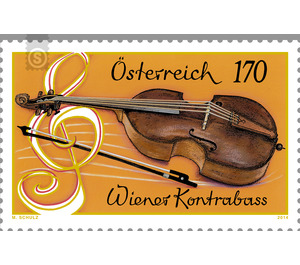Musical instruments - Austria / II. Republic of Austria 2014 - 70 Euro Cent
Theme: Art & Culture
| Country | Austria / II. Republic of Austria |
| Issue Date | 2014 |
| Face Value | 70.00 |
| Edition Issued | 200,000 |
| Printing Type | combination printing |
| Stamp Type | Commemorative |
| Item Type | Stamp |
| Chronological Issue Number | 2459 |
| Chronological Chapter | OOS-OE2 |
| SID | 319897 |
| In 61 Wishlists | |
Continuation of the brand series "Musical Instruments": The new 1.70-Euro-Wert focuses on the "Wiener Kontrabass", a string instrument that was created in this form in the Viennese Classic. The double bass is the deepest of its kind, not to mention of its kinds, since it belongs to two families of instruments. He has features of the violin family, consisting of violin, viola and cello, as well as those of today only more important music historical gamba, of which the bass originally had about the sloping shoulders, the flat bottom and the mostly held from below bow. "Violone", "Contrabasso di viola", "Gross Contra-Bass-Violin" - even old names do not help, if you want to assign the double bass, he remains in this regard an outsider. Only in the course of the 18th century, he became a regular member of the orchestra, soloist he was until then rarely used in known plays. Numerous pieces for double-bass solo finally emerged during the time of the Viennese Classic, in which a very special mood of the instrument prevailed. From the 1760s onwards, a five-string bass was usually used, with the Viennese double bass presented here covered in four strings. The Viennese double bass paved the way for the instrument in the soloist play. In addition, this mood, also called "Viennese tuning", optimized the instrument for use in chamber music. Important concerts were created during this time. Carl Ditters von Dittersdorf, Franz Anton Hoffmeister, Johann Baptist Vanhal and Johann Matthias Sperger composed a lot for the double bass as a solo instrument. Joseph Haydn is said to have written a double bass concerto, which is missing today. Wolfgang Amadeus Mozart, on the other hand, wrote the aria "Per questa bella mano" for the imposing instrument, which also entered the history of music as its own double-bass type under the name "Wiener Quart-Terz-Violon". The double basses are by no means all the same size, the instruments are designed in different scale lengths, which are adapted to the size of each musician. They are played while sitting or standing and adjusted with the sting again to the height of the musician. They can be painted or plucked, they are also often used in jazz music, jazz musicians call the double bass partly affectionately "doghouse" (kennel). The author Patrick Süskind even dedicated the string instrument to his own eponymous play, which provides insights into the soul of a musician. Today, the Vienna Double Bass Archive, founded in 1974 by Prof. Alfred Planyavsky, former double bass player of the Vienna Philharmonic, and handed over to the Music Collection of the Austrian National Library, explores the international contrabass repertoire - with special attention to the Viennese school.


